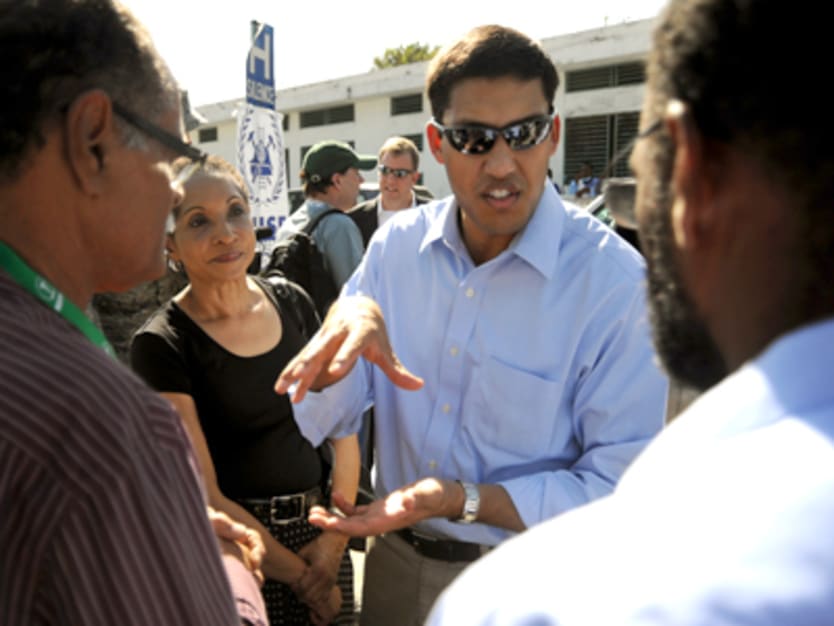
Top White House officials have been pushing for the creation of an interagency panel to coordinate U.S. foreign assistance policy, according to a newly unveiled document that represents the most detailed look yet at sweeping reform plans currently being drafted by the Obama administration.
The document, titled “A New Way Forward on Global Development,” was drafted in the run-up to an April 21 meeting of top administration officials involved in conducting two parallel foreign policy reviews, according to Josh Rogin, who published a copy on the Foreign Policy magazine’s blog The Cable. The draft was prepared by National Security Council staff, Rogin indicates, and it is not final.
The creation of an interagency panel may have the support of Senate Foreign Relations Committee leaders John Kerry (D-Mass.) and Richard Lugar (R-Ind.), but it will not sit well with State Department officials keen on retaining oversight of development policy.
Little surprise, then, that the April 21 meeting between NSC and State Department officials was described as heated.
The draft document seeks to forge a “lasting bipartisan consensus on development policy,” with a focus on streamlining government resources and promoting sustainable development. The goal is to align U.S. resources according to a clear set of policy objectives, not have the budgeting process drive policy.
“The United States will pursue a new approach to global development,” the draft states, “that focuses our government on the critical task of helping to create a world with more prosperous and democratic states, able to meet the needs of their people and to be our partners in addressing common threats, challenges, and opportunities.”
The approach is built on three pillars:
1) A deliberate development policy that places a premium on economic growth and democratic governance, “game-changing” innovations, and sustainable systems for meeting basic human needs.
2) A new business model that positions the United States as a more effective partner and to leverage U.S. leadership.
3) A “modern architecture” that elevates development as a key pillar of U.S. foreign policy and harnesses the development expertise now spread across government in support of common objectives.
According to the draft, U.S. development policy should focus on:
1) Fostering the next generation of emerging markets by ramping up efforts “in support of select countries and sub-regions where the political and economic conditions are right to sustain progress” and working with other bilateral and multilateral donors, companies and nonprofits “from policy conception through to implementation.”
2) Solving long-standing development challenges by boosting public and private investment in “potential game-changers such as vaccines for neglected diseases, weather - resistant seed varieties, and green energy technologies.”
3) Helping developing nations meet basic human needs by placing a “greater emphasis on building sustainable systems” in sectors such as health and agriculture - also when providing humanitarian relief.
4) Tailoring development strategies in post-conflict situations to specific challenges on the ground “by bringing development expertise to bear in designing our interventions and by adopting metrics, appropriate to our objectives and the context, against which we can measure progress.”
5) Maximizing aid effectiveness by using diplomacy to ensure conditions within a partner country favor development, conducting “rigorous” impact assessments, and holding long-time recipients of U.S. assistance accountable for achieving development results – even those countries where assistance has been largely driven by security or policy imperatives.
This targeted approach will require “hard choices” about which regions and sectors to assist, the draft acknowledges, citing global health, food security, democratic governance, support for competitive and open markets “or other areas where we have known advantages” as potential areas of focus for U.S. assistance. The U.S. would “demand greater focus from our assistance programs” in the field, and “reallocate” resources to initiatives that “yield the greatest impact.”
The draft does not explicitly mention procurement reform.
The U.S. would “work with” bilateral and multilateral partners on secondary priorities, and favor budget support for developing countries that are deemed transparent and accountable.
The draft suggests the following actions to create clear lines of authority and generate greater coherence across government:
1) Elevate development as a central pillar of U.S. national security strategy, “equal to diplomacy and defense,” by including the USAID administrator in National Security Council meetings “when appropriate” and by weighing the impact of U.S. policies on developing countries, including policies on trade, intellectual policy and immigration.
2) Strengthen coordination between the State Department and USAID, but continue to have the USAID administrator report to the secretary of state.
3) Create mechanisms for ensuring a coherent government-wide development strategy, by conducting a policy review every four years and creating an interagency Development Policy Committee to coordinate foreign assistance policy across the executive branch.
4) “Reestablish” the U.S. as the global leader on international development by attracting high-quality talent in-house, especially when it comes to policy and planning, budgeting, and key cross-cutting initiatives on food security, global health and other issues.
An “interim” QDDR report is said to be released “soon,” according to Rogin. It is unclear whether the report resulting from the presidential study directive will be officially released.








